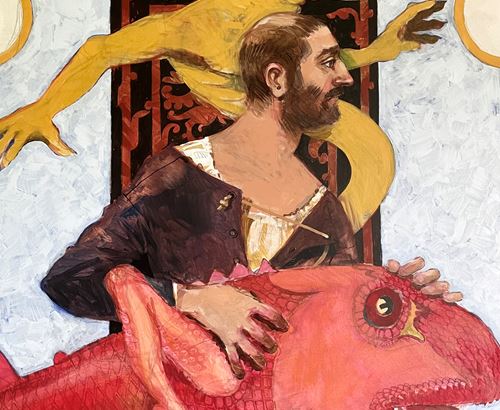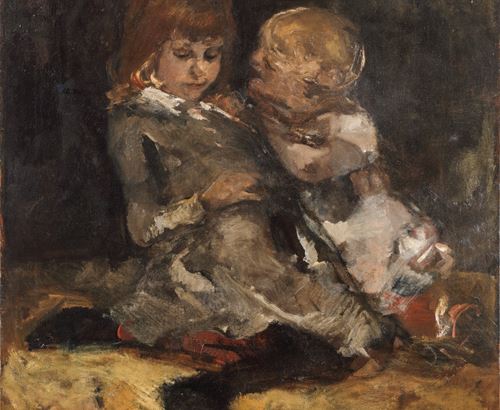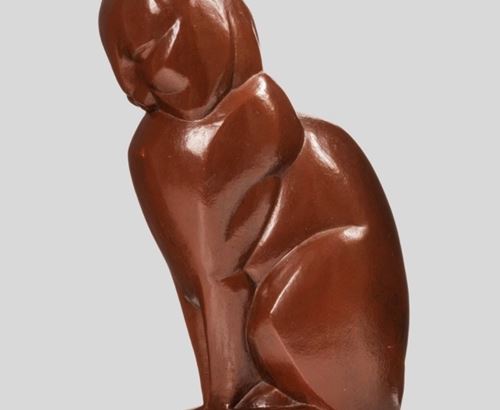The Poet Johannes Nomsz and his wife Anna Maria Telghorst in their Siting Room, Amsterdam
description
Hendrik Pothoven (Amsterdam 1725/1728 - Amsterdam 1807)
oil on canvas
27 ¼ x 32 ¾ inches (69.2 x 83.2 cm.)
Provenance
Johannes Nomsz & Anna Maria Telghorst, and then by descent to their daughter
Anna Elisabeth Marguerat née Nomsz, Old Barneveld, New York, and then presumably to her daughter,
Mme. de Castro, Old Barneveld, New York,
Mrs. Archibald Moore, Old Barneveld, New York
Mrs. Charles Stebbins Fairchild, by 1887 – 1924, who donated it to
The New York Historical Society, New York, 1924 - 1995 until deaccessioned at
Important Old Master Paintings, The Property of the New York Historical Society, Sotheby’s, New York, January 12, 1995, lot 174, (as by Hermanus Numan), where acquired by
Private Collection, New York, until 2023
Literature
Adolphe Staring, De Hollanders Thuis, Gezelschapstukken uit drie eeuwen, Martinus Nijhoff, ‘s-Gravenhage, 1956, p. 156 (as by Hermanus Numan)
J.W. Niemeijer, “De Portretten van Ploos van Amstel” in Nederlands Kunsthistorisch Jaarboek, volume 13, 1962, p. 200 (as by Hermanus Numan)
Earl Roger Mandle, “Hermanus Numan, Portrait of Johannes Nomsz and his Wife in their Sitting Room” in Dutch Masterpieces from the Eighteenth Century: Paintings & Drawings 1700 – 1800, The Minneapolis Institute of Arts, 1971, p. 73, no. 56, plate 74, (as by Hermanus Numan)
David R. Smith, “Rembrandt’s Early Double Portraits and the Dutch Conversation Piece” in The Art Bulletin, volume 64, no. 2, June 1982, figure 43, (as by Hermanus Numan)
R.J.A. te Rijdt, “Figuurstudies door Hendrik Pothoven” in Leids Kunsthistorisch Jaarboek 8, 1989, pp. 350, 352, no. 4, illustrated, 358, fn. 26, 361, 367, (as by Hendrik Pothoven) (also illustrated and discussed is the preparatory drawing by Hendrik Pothoven for this painting depicting Johannes Nomsz now in the collection of the Teylers Museum, Haarlem, pp. 352, no. 5, illustrated, 361, no. 13)
“Hendrick Pothoven, Dubbelportret van Johannes Nomsz en Telghorst” on Collectie Nederland: Musea, Monumenten en Archeologie, at collectionederland.nl
Exhibition
Amsterdam, Stedelijk Museum, February 17 – April 25, 1965
Minneapolis, The Minneapolis Institute of Arts, Dutch Masterpieces from the Eighteenth Century: Paintings & Drawings 1700 - 1800, October 7 – November 14, 1971, no. 56, and traveling to The Toledo Museum of Art, Toledo, Ohio, December 3, 1971 – January 30, 1972, and The Philadelphia Museum of Art, Philadelphia, Pennsylvania, February 17 – March 19, 1972 (as by Hermanus Numan)
Detail Description
In a canal house in Amsterdam Johannes Nomsz (1738 – 1803) the playwright, poet, and essayist along with his wife Anna Maria Telghorst (1734 – 1783) sit in a well-appointed room. Both exquisitely dressed in silk, satin and lace, this painting in all likelihood commemorates their recent marriage in 1771.
Johannes Nomsz was born in Amsterdam the son of a German sailor Hans Nomsz and Alida Fransz Kuvelje. His father died when he was 8, and his mother remarried the wealthy tobacco merchant George Maijer. Nomsz received lessons in language, poetry, French and drawing as well as training in Maijer’s tobacco company. At around 20 he joined the Dutch Navy probably with the idea of becoming an officer. But with the death of his stepfather in 1761, Nomsz returned to Amsterdam to assist his mother in the running of the tobacco business that she inherited. This period also marks the beginning of his writing career initiated by quite a lot of poetry. Prior to his marriage he had also published 5 plays, characterizing himself as “born less for trade than for art”.[1]
Anna Maria Telghorst first married Johann Diederich Kaupe, the owner of a sugar refinery in 1755. His death left her a wealthy widow with three daughters. Nomsz once married, received half ownership in the sugar refinery and combined with the revenue from the tobacco firm, made him a wealthy man. A number of properties were purchased at this time along with a country house in Loenen. The couple had two daughters Anna Alida born in 1773 and Anna Elisabeth in 1775.[2]
Nomsz was one of the most prolific writers of the period, turning out poetry, epics, plays, novels, satires, translations, historical works, critiques and was generally regarded as a wit. Further he was arguably one of the most successful playwrights of the Amsterdam theater at the end of the eighteenth century, with 53 of these works known today. His plays drew full houses, providing desirable roles for actors, and inextricably linked to his success were the most important actors of the period: Johanna Cornelia Wattier – Ziesenis, Geertruida Hilverdink – Grevelink, Andries Shoek and Ward Bingley.[3]
With the death of his wife in September 1783 everything changed. In 1780 the British had declared war against the Dutch in what would come to be known as the Fourth Anglo-Dutch War, from which the British in 1784 emerged victorious leaving the Dutch political and economic foundations in shambles. Trade had come to an almost complete standstill during this period and Nomsz’s business was floundering. With the death of his wife, he was compelled to pay out the value of her estate to his stepdaughters which essentially stripped him of all his liquid assets. Another likely contributing factor was that his writing had taken precedence over the supervision of his commercial ventures. Around 1784 he chose to join the Patriots, a faction that opposed the Stadtholder William V, Prince of Orange in the hopes of improving his finances, although prior to his wife’s death he had firmly supported the prince. This proved to be an ill-fated decision as after 1787 with the Orangist regime back in complete control, Nomsz’s plays were banned from the stage and his display of such political opportunism generally reviled. On August 25, 1803, at the age of 65 Nomsz died a destitute patient of the St. Pietersgasthuis, Amsterdam.[4]
At some point the painting passed to his surviving daughter Anna Elisabeth. She held onto it through two marriages, first with Jan Frederik Frentelman, and following his death in 1811 married Jean David Marguerat. She later emigrated to America and brought the painting with her to the town of Old Barneveld (now Trenton) in upstate New York, famous for its waterfall. It then presumably passed to her daughter Madame de Castro and later came into the possession of Mrs. Archibald Moore, both of Old Barneveld. By 1877 it belonged to Helen Krumbhaar (Lincklaen) Fairchild, the wife of Charles Stebbins Fairchild who served as the U.S. Secretary of the Treasury under Grover Cleveland, and had a home in Cazenovia, New York. Significantly, Helen Fairchild edited and contributed to the autobiography Francis Adrian Van der Kemp 1752 – 1829 in 1903.
Van der Kemp had been one of the radical leaders of the Patriots, jailed for his activities, and later emigrated to America eventually settling in Old Barneveld where there was an established Dutch community. In America Van der Kemp was well respected and quite influential. He corresponded with Thomas Jefferson, George Washington, Benjamin Franklin, Alexander Hamilton, and John and Abigail Adams.[5] Fascinatingly in the book Fairchild describes how Johannes Nomsz’s daughter “Madame Marguerat” and her daughter “Madame de Castro” lived with the best friend of Van der Kemp’s daughter.[6] Besides donating this work to The New York Historical Society, Fairchild also gave them a portrait of Van der Kemp.
The New York Historical Society was established in 1804 and until the Metropolitan Museum of Art opened in 1870, was the most important art museum in New York. By 1994 The New York Historical Society’s collection had become vast and unwieldly. The decision was made to narrow their focus to objects related solely to New York’s history,[7] and what followed was a landmark sale of important old master paintings at Sotheby’s New York on January 12, 1995. Although misattributed to Hermanus Numan this painting was sold to a private collector in New York who kept it for the next 28 years.
It was first identified as a work by Hendrick Pothoven by R.J.A. te Rijdt in 1989, based on a signed figure study in black and white chalk of Nomsz, a preparatory sketch for this work, now in the Teylers Museum, Haarlem. Once established Te Rijdt felt the portrait of Nomsz and his wife to be one of Pothoven’s most attractive conversation pieces.[8]
Born in Amsterdam, Pothoven trained at the Academie der Teekenkunst in 1743. He was also a pupil of Frans de Bakker and Philip van Dijk who seems to have been a relative. He executed portraits, cityscapes, landscapes, interior views, figure studies and engravings. Many of his portraits were also engraved by other artists. His wife was Maria van den Elburg, and they resided in The Hague from 1746 – 1764, and then returned to Amsterdam.[9] Pothoven’s genius lay in. “his power to suggest the character of his subjects”[10] which perhaps is most obvious in his conversation pieces. In these works, while ensconced in fashionable rooms and swathed in finery, his sitters’ pretensions and aspirations are on full display. Other conversation pieces by Pothoven are in the Rijksmuseum and Amsterdam Museum, with paintings, drawings, and engravings in numerous museums mainly throughout The Netherlands.
The recounting of Johannes Nomsz and Anna Maria Telghorst’s life stories in the latter part of eighteenth-century Amsterdam is a particularly dramatic one. Telghorst appears to have tried to be a supportive wife to both her husbands, fulfilling her role as helpmate and mother. Johannes Nomsz from obscure beginnings gained wealth and fame only to lose it all and seal his fate with wrongheaded political choices. Although Nomsz died a pauper, their portrait survived and regained new status in America due to shifting political ideologies. While in the collection of The New York Historical Society for 71 years, it was loaned to other museum exhibitions and documented in art historical literature. Afterwards it was held in a private collection for 28 years. With its reemergence and now correct attribution, the significance of Pothoven’s portrayal is firmly established.
[1] Biographical information taken from R. Zuidema, “Johannes Nomsz” in Nieuw Nederlandsch Biografisch Woordenboek, volume 7, A.W Sijthoff, Leiden, 1927, p. 912; and W.A.P. Smit, Kalliope in de Nederlanden, Gorcum b.v., Konink. Van., 1975, p. 776.
[2] W.A.P. Smit, op.cit., p. 776.
[3] W.A.P. Smit, op.cit., p.777; and G.J. van Bork & P.J. Verkruijsse, De Nederlandse en Vlaamse Auteurs, De Haan, 1985, p. 413.
[4] W.P.A. Smit, op.cit., p. 777; and G.J. van Bork, op.cit., p. 413.
[5] Biographical information taken from Henry F. Jackson, Scholar in the Wilderness: Francis Adrian Van der Kemp, Syracuse University Press, 1963; and Lucas Ligtenberg, De Nieuwe Wereld van Peter Stuyvesant, Nederlandse voetsporen in de Verenigde Staten, Balans, 1999, p. 77.
[6] Helen Lincklaen Fairchild, ed., Francis Adrian van der Kemp 1752 – 1829, an Autobiography, The Knickerbocker Press, New York, 1903, p. 202.
[7] Betsy Gotbaum, “Reinventing The New York Historical Society” in Important Old Master Paintings, The Property of The New York Historical Society, Sotheby’s, January 12, 1995, unpaginated.
[8] R.J.A. Rijdt, op.cit., p. 350.
[9] Biographical information taken from Earl Roger Mandle, “Hendrick Pothoven”, op.cit., p. 79.
[10] Earl Roger Mandle, “Hendrick Pothoven”, op.cit., p. 79.
contact
Lawrence Steigrad Fine Arts
10023 New York
United States
T (212) 517-3643
M 9175091429
larry@steigrad.com
www.steigrad.com/





